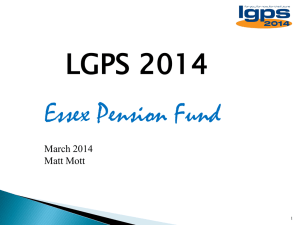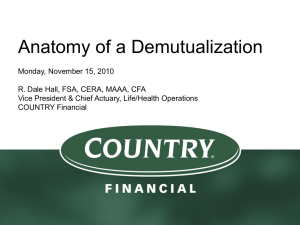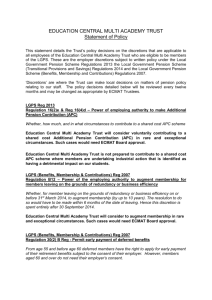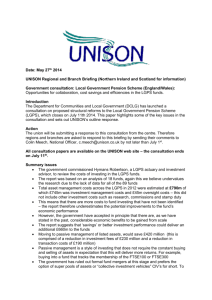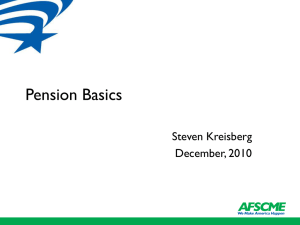Local Government Pension Scheme
advertisement
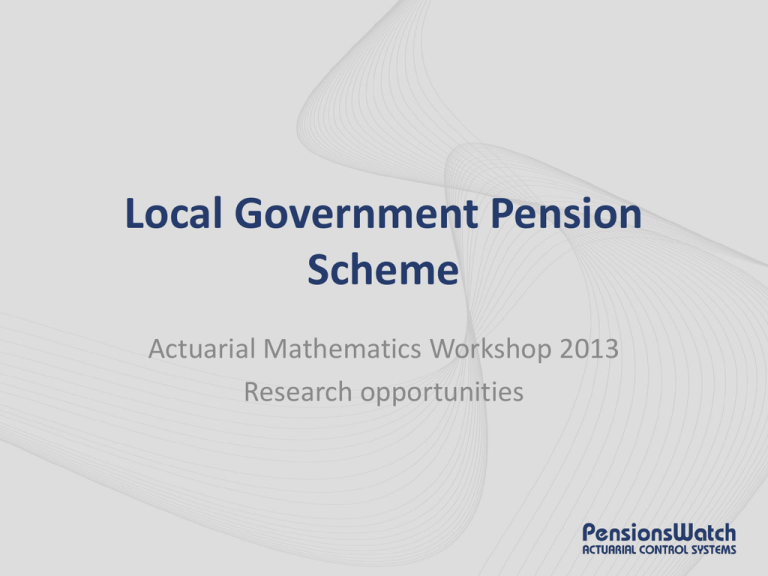
Local Government Pension Scheme Actuarial Mathematics Workshop 2013 Research opportunities Introduction Local Government Pension Scheme LGPS overview - some facts and figures • Established by the Superannuation Act 1972 • Open to employees working in local government, those working for participating employers and some councillors • A multi-employer funded defined benefits pension scheme • Comprises 101 regional funds in the UK • Approx 10,000 employers and growing (e.g. academies) • Approx 1.6 million contributing members • Benefit payments in 2011-2012 were approx £7.5 billion • Assets end of March 2012 were approx £148 billion • 4th largest DB pension scheme in the world LGPS overview – benefit structure • • • • • • Pre April 2008 final salary (1/80th pension + 3/80th cash) Post April 2008 final salary (1/60th pension + commutation) Post April 2014 CARE (1/49th pension + commutation) Contributory Complex legacy protections Highly political LGPS overview – what do actuaries do? • Triennial funding valuations to recommend contribution rates for existing employers • Provision of strategic investment advice (stochastic modelling) • Risk assessments and contribution rates for new employers • Cessation valuations for exiting employers • Financial reporting for individual employers under FRS17 and IAS19 (now represents more than half of all activity) LGPS overview – actuarial capacity issues • Only 4 actuarial firms have any significant presence in the LGPS marketplace • Considered low margin business by most proprietary consulting firms • Regarded as highly specialist • Significant capacity problems • Currently low levels of investment in systems and staff particularly with general decline in DB pension schemes • Fund Actuaries also carry out work for employers – significant potential for conflicts of interest Introducing PensionsWatch PensionsWatch • Seven directors and two freelance consultants (actuarial, LGPS, IT, legal, business skills) • Innovative new service aimed at providing low-cost independent actuarial advice directly to LGPS employers • Core offering is a package comprising financial reporting and related monitoring of funding measures, outsourcing advice and general actuarial support • Unique selling point is a web-based service delivery through our NeXtStep platform • Our objective is to significantly expand market capacity, bringing affordable and independent actuarial services within the reach of ordinary LGPS employers Research opportunities Selection criteria Selection criteria • • • • Suited to a mathematical or statistical treatment Provides solutions needed by industry Must be capable of practical application Provides solutions that are of commercial value to consulting actuarial firms, audit firms, standards setters and regulatory bodies • OR that serve the public interest (through cost reductions and greater efficiency) Research opportunities #1 Quantifying the error inherent in pension liability roll-forward processes Roll-forward – what is it? • A simplified mathematical model designed as a substitute for performing an accurate valuation of pension scheme liabilities • A practical response to time and cost constraints • Greatly simplifies data requirements • Quicker to run • Less skilled operators required • Routinely used for the majority of financial reporting exercises (FRS17 & IAS19) in both public and private sectors Roll-forward – what are the issues? • No-one has any real understanding of the magnitude of error inherent in the process • Auditors routinely ask questions about the size of the potential error but place reliance on response from actuary • Actuaries tend to be circumspect in their answers • No real tools or techniques exist to identify the conditions that give rise to errors and potential magnitude • The risk is that there may be material misstatement of pensions figures going into accounts Roll-forward – research linked to the LGPS • The LGPS presents a unique opportunity for a statistically based study into roll forward methodology • We estimate there are around 6,000 LGPS employers that currently report under FRS17 & IAS19 • All FRS17 and IAS19 data exists in the public domain and may also be obtained from Whole of Government Accounts • Accurate results also exist as they are produced for the funds every 3 years for reporting under IAS26 • Regression models could be developed that attempt to explain the link between employer and data characteristics and the observed level of reporting error Roll-forward research – who benefits? • Potentially of significant value to the major audit firms – better placed to insist on full valuations – more accurate financial reporting • Actuarial firms unlikely to complain – more work! • Investors and users of accounts can have greater confidence in the reliability of pensions information Research opportunities #2 Quantifying the error from using index returns in place of actual investment returns Index returns – the issue • Index-based estimated returns are frequently used when actual investment data is not available • Common situations include bulk transfers, financial reporting, interim valuations and in calculating new employer contribution rates • The approach has very simple data requirements (split portfolio into major asset classes, multiply by index-based returns, add up to get total estimated return) • Almost invariably, index returns do not match the actual data when it eventually becomes available Index returns – potential research • Statistical based studies or theoretical treatment possible • Vast amounts of potential data available to generate actual vs expected data • Actuarial firms could be interviewed to understand approaches • Can a link be established between the data, fund or asset characteristics that helps to quantify and explain the potential errors? • Can better models be constructed and tested in the light of this research? Index returns – who benefits? • Likely to be of interest to actuarial and audit firms • Better estimation models will improve accuracy in financial reporting • Auditors will be better positioned to know when estimation techniques will be acceptable or will be better able to understand the potential error Research opportunities #3 Yield curves and the derivation of FRS17 & IAS19 discount rates FRS17 and IAS19 discount rates • FRS17 requires use of a discount rate based on AA-rated corporate bonds of equivalent term and currency to the pension liabilities • IAS19 requires use of high quality corporate bond yields • In practice most firms use the same approach for both standards • In the early days of the standards the use of a single index figure was commonplace (e.g. iBoxx AA indices) • Larger firms now moved away from this and most use proprietary yield curves • Audit firms appear to favour this approach Yield curve research – the problem • The principal problem is that the duration of liabilities for most pension schemes is higher than the duration of the bonds on which the curves are based Responses • Ignore issue and continue to use a simple index figure • Curve fitting models developed using extrapolation • Pragmatic solutions based on the gilts curve (does extend to the required durations) • Subjective individual “judgement” applied Yield curves research – possibilities • A research paper on various curve fitting methodologies, their behaviour under different financial conditions and practical implications for discount rates • Research into the relationship between gilts and corporate bonds (credit spreads) and the potential family of curves that could be derived from using the gilts curve as a base • Development of a high quality open source yield curve model based on publicly available data for use as a reference source for actuarial firms and auditors Yield curve research – who benefits? • Reduced cost to industry as numerous proprietary models likely to become defunct if a free alternative exists • Potential for greater consistency in financial reporting (one of original purposes of the standards) • If offered as open-source there is a significant opportunity for the University to raise its profile within the industry Research opportunities #4 The construction and design of proxy mortality tables Proxy mortality tables – the issue • LGPS funds are big enough to generate their own statistically significant mortality data • Historically, scheme specific QX tables have been constructed and expressed as adjustments to standard CMIB tables (standard industry practice) • In recent years we have seen the emergence of proprietary mortality tables, usually postcode-based • Very little information regarding these tables is available to auditors and third-party providers of actuarial services • Lack of transparency undermines confidence and leads to higher costs Proxy mortality tables – research • Objective would be to develop an optimising algorithm that, for a given set of data points (usually life expectancies at set ages) leads to a best fit curve with desirable characteristics in relation to a supplied set of input reference curves • Output in the form of industry-standard adjustments to standard tables Proxy mortality tables – who benefits? • Impact on auditors and third-party suppliers is minimised, leading to reduced costs and time in preparing work • Easier for third parties to manipulate valuation results for other purposes if proxy tables can be identified quickly Thank you Questions
